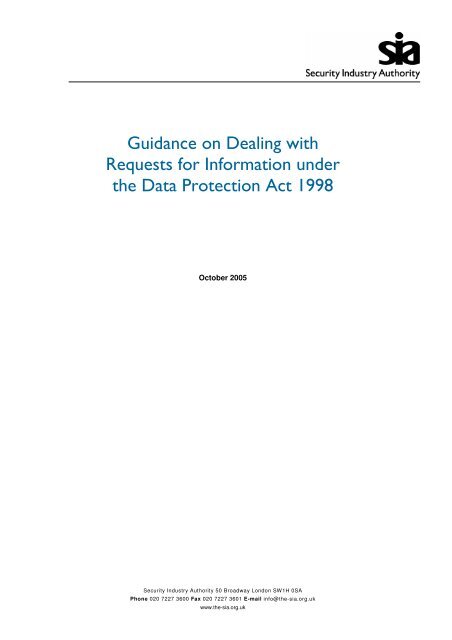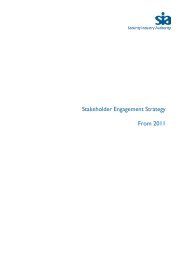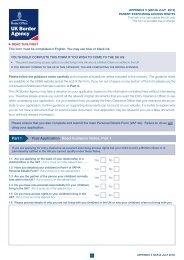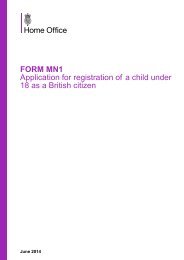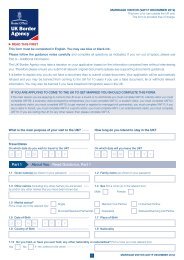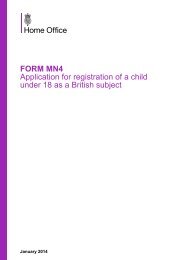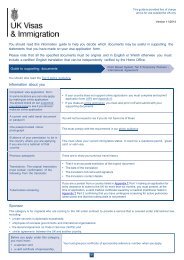policy on dealing with requests for information - Security Industry ...
policy on dealing with requests for information - Security Industry ...
policy on dealing with requests for information - Security Industry ...
Create successful ePaper yourself
Turn your PDF publications into a flip-book with our unique Google optimized e-Paper software.
October 2005<strong>Security</strong> <strong>Industry</strong> Authority 50 Broadway L<strong>on</strong>d<strong>on</strong> SW1H 0SAPh<strong>on</strong>e 020 7227 3600 Fax 020 7227 3601 E-mail info@the-sia.org.ukwww.the-sia.org.uk
C<strong>on</strong>tentsA. SummaryB. Introducti<strong>on</strong>C. What in<strong>for</strong>mati<strong>on</strong> is covered under the DPA?D. What rights are af<strong>for</strong>ded to individuals under the DPA?E. What is the right of subject access?F. How do staff identify a Subject Access Request underthe DPA?G. How will SIA staff deal <strong>with</strong> an SAR?H. If you want to make an SAR, what should you do?I. What if the in<strong>for</strong>mati<strong>on</strong> requested c<strong>on</strong>tains pers<strong>on</strong>aldata about another pers<strong>on</strong>?J. Under what c<strong>on</strong>diti<strong>on</strong>s may disclosure be exempt?K. Can the SIA disclose pers<strong>on</strong>al in<strong>for</strong>mati<strong>on</strong> to a thirdparty?L. What can the data subject do if the SIA does notprovide the in<strong>for</strong>mati<strong>on</strong>?Annex AAnnex BAnnex CAnnex DData Protecti<strong>on</strong> PrinciplesOther Relevant Legislati<strong>on</strong>[NB: Under Review]Draft Letter – Refusal to Supply Pers<strong>on</strong>al In<strong>for</strong>mati<strong>on</strong>under the DPAPage 2 of 13
A. SummaryThis guidance provides SIA staff <strong>with</strong> an understanding of their obligati<strong>on</strong>s under the DataProtecti<strong>on</strong> Act 1998 (the DPA) and their role in <strong>dealing</strong> <strong>with</strong> <strong>requests</strong> <strong>for</strong> pers<strong>on</strong>alin<strong>for</strong>mati<strong>on</strong> (or pers<strong>on</strong>al data as it is defined in the Act). It also explains how to make arequest <strong>for</strong> pers<strong>on</strong>al data under the DPA.The DPA gives individuals various rights <strong>with</strong> regard to their pers<strong>on</strong>al data, central to thesebeing the right of access to in<strong>for</strong>mati<strong>on</strong>. The Act also requires public authorities to abide byeight principles when processing pers<strong>on</strong>al data.The Data Protecti<strong>on</strong> Officer (DPO), who will normally manage all <strong>requests</strong> <strong>for</strong> pers<strong>on</strong>aldata, will c<strong>on</strong>tact appropriate staff in each area to undertake a search <strong>for</strong> in<strong>for</strong>mati<strong>on</strong> asrequested. Staff will need to adhere to strict time limits in completing the search and<strong>for</strong>warding their results, in order to meet legislative timeframes <strong>for</strong> resp<strong>on</strong>ding to <strong>requests</strong>.In<strong>for</strong>mati<strong>on</strong> <strong>requests</strong> received by the SIA must meet the c<strong>on</strong>diti<strong>on</strong>s specified in Secti<strong>on</strong> Hbe<strong>for</strong>e processing can commence. The statutory timeframe <strong>for</strong> reply of 40 calendar daysdoes not start until these c<strong>on</strong>diti<strong>on</strong>s are met.The DPO must be c<strong>on</strong>sulted if staff c<strong>on</strong>sider that the in<strong>for</strong>mati<strong>on</strong> being requested may beexempt from disclosure. Each instance where an exempti<strong>on</strong> may apply will be c<strong>on</strong>sidered<strong>on</strong> a case by case basis.Additi<strong>on</strong>al factors must be c<strong>on</strong>sidered when <strong>dealing</strong> <strong>with</strong> in<strong>for</strong>mati<strong>on</strong> <strong>requests</strong> which involvethird parties (where either the in<strong>for</strong>mati<strong>on</strong> requested by an individual makes reference to athird party, or the request itself is made by a third party about a specific individual).B. Introducti<strong>on</strong>This guidance aims to set out SIA <str<strong>on</strong>g>policy</str<strong>on</strong>g> and procedures <strong>for</strong> <strong>dealing</strong> <strong>with</strong> <strong>requests</strong> <strong>for</strong>in<strong>for</strong>mati<strong>on</strong> under the DPA. The SIA is a data c<strong>on</strong>troller <strong>for</strong> the purposes of this Act. It alsoaims to provide assistance in how to identify a request under the DPA, and whenexempti<strong>on</strong>s from disclosure may apply.SIA staff will be made fully aware of the in<strong>for</strong>mati<strong>on</strong> provided in this guidance as theresp<strong>on</strong>sibility to ensure our activities comply <strong>with</strong> the DPA rests <strong>with</strong> each staffmember. Staff should follow this guidance when disclosing any in<strong>for</strong>mati<strong>on</strong> held by the SIA,so that a c<strong>on</strong>sistent approach is adopted.The DPA primarily seeks to protect pers<strong>on</strong>al data from unnecessary use and disclosure,and ensures individuals are made aware of and have c<strong>on</strong>trol over the extent to which theirpers<strong>on</strong>al data are used or disclosed. The data protecti<strong>on</strong> principles, which must be appliedin order to process in<strong>for</strong>mati<strong>on</strong> lawfully, are provided at Annex A. The DPA took effect from1 March 2000.Processing and disclosure of pers<strong>on</strong>al in<strong>for</strong>mati<strong>on</strong> held by the SIA is also governed by theHuman Rights Act and the comm<strong>on</strong> law Duty of C<strong>on</strong>fidence. Background to these statutesare provided at Annex B.The DPA requires that data c<strong>on</strong>trollers register all uses of pers<strong>on</strong>al data throughNotificati<strong>on</strong> to the In<strong>for</strong>mati<strong>on</strong> Commissi<strong>on</strong>er. The SIA’s Notificati<strong>on</strong> has been included <strong>on</strong> apublic register and can be searched <strong>on</strong> the In<strong>for</strong>mati<strong>on</strong> Commissi<strong>on</strong>er’s website(www.in<strong>for</strong>mati<strong>on</strong>commissi<strong>on</strong>er.gov.uk). Any changes to the way SIA staff processpers<strong>on</strong>al data must be notified to the In<strong>for</strong>mati<strong>on</strong> Commissi<strong>on</strong>er <strong>with</strong>in 28 days, by law.Staff are to discuss <strong>with</strong> the DPO any proposals <strong>for</strong> such changes as a matter of priority,but in any case prior to any changes being introduced.Page 3 of 13
For further guidance or advice <strong>on</strong> any of the matters addressed by this guidance, pleasec<strong>on</strong>tact the SIA’s DPO (c<strong>on</strong>tact details provided at paragraph 50).C. What in<strong>for</strong>mati<strong>on</strong> is covered under the DPA?The DPA applies to all pers<strong>on</strong>al in<strong>for</strong>mati<strong>on</strong> or data held by the SIA.Pers<strong>on</strong>al data is in<strong>for</strong>mati<strong>on</strong> about a living individual who can be identified from that data orother available in<strong>for</strong>mati<strong>on</strong>. A reference to a pers<strong>on</strong>’s name <strong>on</strong> its own may not be sufficientto qualify the in<strong>for</strong>mati<strong>on</strong> as pers<strong>on</strong>al data. It must name and directly refer to the individualsuch that that individual is the focus of the in<strong>for</strong>mati<strong>on</strong>. Pers<strong>on</strong>al data does not coverin<strong>for</strong>mati<strong>on</strong> about companies.Some pers<strong>on</strong>al data are classified as ‘sensitive’, and additi<strong>on</strong>al c<strong>on</strong>diti<strong>on</strong>s apply whenprocessing it. Sensitive pers<strong>on</strong>al data relate to a pers<strong>on</strong>’s:• race or ethnic origin• political opini<strong>on</strong>s• religious beliefs• trade uni<strong>on</strong> membership• physical or mental health or c<strong>on</strong>diti<strong>on</strong>• sexual life• alleged or committed offences, or proceedings about such offencesPers<strong>on</strong>al data falls <strong>with</strong>in the scope of the DPA if it is automatically processed (ie.computerised, including email, CCTV and text messages), or is held manually (ie. paperfiles) as part of a relevant filing system, which is a system that:• relates to a set of in<strong>for</strong>mati<strong>on</strong> about an individual;• is structured by either reference to individuals or reference to criteria relating toindividuals; and• makes specific in<strong>for</strong>mati<strong>on</strong> about a particular individual readily accessible.It is important to remember that since 1 January 2005, unstructured manual records whichc<strong>on</strong>tain pers<strong>on</strong>al data may be captured and disclosable under the Freedom of In<strong>for</strong>mati<strong>on</strong>Act 2000. However, it is useful to note that obligati<strong>on</strong>s under the DPA are slightly differentto those under the FOIA (<strong>for</strong> instance, the timeframes <strong>for</strong> resp<strong>on</strong>se and exempti<strong>on</strong>savailable).D. What rights are af<strong>for</strong>ded to individuals under the DPA?The DPA gives individuals rights about how their pers<strong>on</strong>al data may be processed,including a right of access to that in<strong>for</strong>mati<strong>on</strong>. These rights can be summarised as follows:• the right of subject access• the right to prevent damage or distress caused by processing• the right to prevent direct marketing• the right to prevent fully automated decisi<strong>on</strong> taking• the right of redress - compensati<strong>on</strong>, rectificati<strong>on</strong>, blocking or erasure• the right of recourse to the In<strong>for</strong>mati<strong>on</strong> Commissi<strong>on</strong>erE. What is the right of subject access?An individual’s right to access in<strong>for</strong>mati<strong>on</strong> held about them (the subject of the data isreferred to as the data subject in the DPA) is provided <strong>for</strong> under secti<strong>on</strong> 7 of the DPA. Thisright entitles individuals:Page 4 of 13
• To be told whether the SIA, or a representative <strong>on</strong> behalf of the SIA, is processingpers<strong>on</strong>al data about that individual (where processing includes collecting, holding,storing, recording, disclosing, destroying or otherwise using that in<strong>for</strong>mati<strong>on</strong>).• If pers<strong>on</strong>al data are being processed, then that individual is to be given adescripti<strong>on</strong> of:ooothe pers<strong>on</strong>al data;the purposes <strong>for</strong> which the data are or will be processed;the parties to whom the data are or may be disclosed.• If processing is occurring, to also be given an adequately explained <strong>for</strong>m of:oothe in<strong>for</strong>mati<strong>on</strong> c<strong>on</strong>stituting any pers<strong>on</strong>al data (a copy of the in<strong>for</strong>mati<strong>on</strong>must be provided unless it would involve disproporti<strong>on</strong>ate ef<strong>for</strong>t or theindividual agrees otherwise);the source of the in<strong>for</strong>mati<strong>on</strong>, if known.The following secti<strong>on</strong>s describe how the SIA will fulfil its obligati<strong>on</strong> to provide data subjectsaccess to in<strong>for</strong>mati<strong>on</strong> about them, and includes the circumstances under which access maybe refused or restricted (see secti<strong>on</strong> J).F. How do staff identify a Subject Access Request under the DPA?A request <strong>for</strong> in<strong>for</strong>mati<strong>on</strong> made under the DPA is known as a subject access request(SAR). However, a pers<strong>on</strong> need not make any specific reference to the DPA in order <strong>for</strong> theSIA to treat their request as an SAR. The in<strong>for</strong>mati<strong>on</strong> requested must simply fall <strong>with</strong>in theremit of pers<strong>on</strong>al data, as defined by the DPA (see secti<strong>on</strong> C).The SIA is not obliged to provide any in<strong>for</strong>mati<strong>on</strong> unless:• the SAR is made in writing (including in electr<strong>on</strong>ic <strong>for</strong>m);• it is accompanied by any required fee (a maximum fee of £10 has been prescribedby legislati<strong>on</strong> and the individual will be in<strong>for</strong>med if payment of the fee is required);• the SIA is satisfied <strong>with</strong> the identity of the pers<strong>on</strong> requesting the in<strong>for</strong>mati<strong>on</strong>;• sufficient in<strong>for</strong>mati<strong>on</strong> to locate the in<strong>for</strong>mati<strong>on</strong> has been provided.If further in<strong>for</strong>mati<strong>on</strong> is required to c<strong>on</strong>firm a pers<strong>on</strong>’s identity or to locate the in<strong>for</strong>mati<strong>on</strong>requested, the SIA will in<strong>for</strong>m the individual of the requirement <strong>for</strong> that further in<strong>for</strong>mati<strong>on</strong>.G. How will SIA staff deal <strong>with</strong> an SAR?All SARs are to be referred from the SIA’s managed service provider to the SIACorresp<strong>on</strong>dence Handling Team (CHT) up<strong>on</strong> receipt. The DPO will also be kept advised ofall SARs and must be notified where an exempti<strong>on</strong> is employed. Each SAR will be loggedto ensure they are effectively managed and checked <strong>for</strong> completeness be<strong>for</strong>e c<strong>on</strong>tactingrelevant staff members to undertake a search <strong>for</strong> the requested in<strong>for</strong>mati<strong>on</strong>. A checklist <strong>for</strong>identifying a complete SAR and how to process it is shown at Annex C.Staff members c<strong>on</strong>tacted will prioritise any work related to SARs received by the SIA,subject to other work deadlines. In any case, all SIA staff will complete a search <strong>with</strong>in fiveworking days, unless otherwise agreed <strong>with</strong> the DPO or CHT. Staff will be given a clearindicati<strong>on</strong> of the search they will be required to carry out, and it is likely that an SAR willaffect more than <strong>on</strong>e SIA team. Search results are to be <strong>for</strong>warded to the CHT, to enablethem to prepare a resp<strong>on</strong>se to the data subject (<strong>with</strong> advice sought from the DPO asnecessary). C<strong>on</strong>tributing staff will check and approve resp<strong>on</strong>ses prior to despatch.Page 5 of 13
SARs should be addressed to:Data Protecti<strong>on</strong> OfficerThe <strong>Security</strong> <strong>Industry</strong> AuthorityPO Box 9Newcastle Up<strong>on</strong> TyneNE82 6YXFax: 08702 430 125Email: info@the-sia.org.ukA template <strong>for</strong> making a request <strong>for</strong> in<strong>for</strong>mati<strong>on</strong> is available <strong>on</strong> the SIA’s website. It can befound <strong>on</strong> the ‘Freedom of In<strong>for</strong>mati<strong>on</strong>’ page.SIA staff are also entitled to submit an SAR. These should be made <strong>on</strong> the SAR <strong>for</strong>mprovided in the Staff Handbook (see Appendix M of that handbook).I. What if the in<strong>for</strong>mati<strong>on</strong> requested c<strong>on</strong>tains pers<strong>on</strong>al data aboutanother pers<strong>on</strong>?Where an SAR covers in<strong>for</strong>mati<strong>on</strong> which relates to pers<strong>on</strong>s other than the data subject (athird party), the usual data protecti<strong>on</strong> rules will apply to the in<strong>for</strong>mati<strong>on</strong> about that thirdparty. In such circumstances, the SIA is not required to give access to the in<strong>for</strong>mati<strong>on</strong>,except where:• the third party has given c<strong>on</strong>sent to disclosure of their pers<strong>on</strong>al data to the pers<strong>on</strong>making the SAR; or• c<strong>on</strong>sidering all of the circumstances, it is reas<strong>on</strong>able to make the disclosure <strong>with</strong>outthe third party’s c<strong>on</strong>sent. The criteria specified in the DPA are:• any duty of c<strong>on</strong>fidentiality owed to the third party;• any steps the SIA has taken to seek c<strong>on</strong>sent;• whether the third party is capable of giving c<strong>on</strong>sent; and• any express refusal of c<strong>on</strong>sent by the third party.If the SIA c<strong>on</strong>siders it unreas<strong>on</strong>able to make the disclosure and c<strong>on</strong>sent is not given, theSIA must take steps to make as much in<strong>for</strong>mati<strong>on</strong> as possible available <strong>with</strong>out revealingthe identity of the third party (eg. by removing all identifying particulars such as name).J. Under what c<strong>on</strong>diti<strong>on</strong>s may disclosure be exempt?Where pers<strong>on</strong>al data are processed <strong>for</strong> certain purposes, exempti<strong>on</strong>s under the DPA mayapply. However, many of these exempti<strong>on</strong>s are c<strong>on</strong>diti<strong>on</strong>al and are subject to a prejudicetest. They may <strong>on</strong>ly be applied <strong>on</strong> a case by case basis. Staff must there<strong>for</strong>e c<strong>on</strong>sult <strong>with</strong>the DPO should they c<strong>on</strong>sider that an exempti<strong>on</strong> may apply to any specific case.Exempti<strong>on</strong>s under the DPA are available <strong>for</strong> several purposes, including the following:• the preventi<strong>on</strong> or detecti<strong>on</strong> of crime or prosecuti<strong>on</strong> of offenders• the assessment of any tax or duty• the discharging of regulatory functi<strong>on</strong>s, where such functi<strong>on</strong>s are likely to beprejudiced (such as in licensing staff engaged in the private security industry)• unstructured manual pers<strong>on</strong>al data• in<strong>for</strong>mati<strong>on</strong> available by enactment• disclosures required by law or in c<strong>on</strong>necti<strong>on</strong> <strong>with</strong> legal proceedings• parliamentary privilege• management <strong>for</strong>ecasts and corporate financePage 7 of 13
Data Protecti<strong>on</strong> PrinciplesThe eight data protecti<strong>on</strong> principles (DPPs) underpin the DPA and must be followed whenprocessing pers<strong>on</strong>al data (except where an exempti<strong>on</strong> applies).The DPPs listed in Schedule 1 of the Act are:1. Pers<strong>on</strong>al data shall be processed fairly and lawfullyThe requirement that processing is ‘lawful’ means that it must be in accordance <strong>with</strong> allrelevant rules of law whether derived from statute or comm<strong>on</strong> law.The requirement that processing must be ‘fair’ means that individuals must have, beprovided <strong>with</strong>, or have made readily available to them, certain in<strong>for</strong>mati<strong>on</strong>. This in<strong>for</strong>mati<strong>on</strong>relates to the purpose or purposes <strong>for</strong> which the data are being or may be processed, theidentity of the pers<strong>on</strong> or organisati<strong>on</strong> (or its representative) who will be carrying out theprocessing, and any other necessary in<strong>for</strong>mati<strong>on</strong>.In additi<strong>on</strong> to meeting the ‘fair and lawful’ tests, when processing pers<strong>on</strong>al data at least <strong>on</strong>eof the c<strong>on</strong>diti<strong>on</strong>s in Schedule 2 of the Act must be met. A key c<strong>on</strong>diti<strong>on</strong> is where the datasubject has given c<strong>on</strong>sent to the processing, but other c<strong>on</strong>diti<strong>on</strong>s are where the processingis in the legitimate interests of the SIA or a third party to whom the data are disclosed,where processing is c<strong>on</strong>nected to legal or c<strong>on</strong>tractual obligati<strong>on</strong>s, the processing is in thevital interests (ie. life or death) of the data subject, and the processing occurs in c<strong>on</strong>necti<strong>on</strong><strong>with</strong> the administrati<strong>on</strong> of justice, the functi<strong>on</strong>s of the Crown, a Minister of the Crown, or agovernment department, or functi<strong>on</strong>s imposed through any enactment.Where data are sensitive (as per paragraph 15), then at least <strong>on</strong>e of the additi<strong>on</strong>alc<strong>on</strong>diti<strong>on</strong>s in Schedule 3 of the Act must also be met. C<strong>on</strong>diti<strong>on</strong>s <strong>for</strong> processing sensitivepers<strong>on</strong>al data require an additi<strong>on</strong>al level of preciseness than <strong>for</strong> pers<strong>on</strong>al data. Keyc<strong>on</strong>diti<strong>on</strong>s are where the data subject gives his/her explicit c<strong>on</strong>sent (eg. signed c<strong>on</strong>sent), orwhere the data subject has taken deliberate steps to make the in<strong>for</strong>mati<strong>on</strong> public. Otherc<strong>on</strong>diti<strong>on</strong>s which may apply to the SIA cover processing in<strong>for</strong>mati<strong>on</strong> in c<strong>on</strong>necti<strong>on</strong> <strong>with</strong> legalrights and proceedings, the administrati<strong>on</strong> of justice, the vital interests of the data subject oranother pers<strong>on</strong>, the functi<strong>on</strong>s of the Crown, a Minister of the Crown, or a governmentdepartment, and functi<strong>on</strong>s imposed through any enactment.In additi<strong>on</strong>, processing of sensitive in<strong>for</strong>mati<strong>on</strong> may also occur under c<strong>on</strong>diti<strong>on</strong>s outlined inthe Data Protecti<strong>on</strong> (Processing of Sensitive Pers<strong>on</strong>al Data) Order 2000. The primaryc<strong>on</strong>diti<strong>on</strong>s which may apply to the SIA are where processing is in the substantial publicinterest and is necessary to prevent or detect crime, or is necessary <strong>for</strong> the discharge of apublic functi<strong>on</strong> designed to protect members of the public against a pers<strong>on</strong>’s seriouslyimproper c<strong>on</strong>duct or incompetence.Note also, that even if all c<strong>on</strong>diti<strong>on</strong>s under the first DPP are met, processing would not befair and lawful unless it meets all other DPPs and legislative obligati<strong>on</strong>s.2. Pers<strong>on</strong>al data shall be processed <strong>for</strong> specified purposesPers<strong>on</strong>al data should <strong>on</strong>ly be processed <strong>for</strong> the purpose or purposes <strong>for</strong> which it wascollected or obtained. When any member of the public is asked <strong>for</strong> pers<strong>on</strong>al data, theyshould be in<strong>for</strong>med as to the purpose or purposes <strong>for</strong> which that data will be processed.No processing is permitted outside those purposes notified to the In<strong>for</strong>mati<strong>on</strong>Commissi<strong>on</strong>er in the SIA’s notificati<strong>on</strong> (a copy of which can be found <strong>on</strong> the In<strong>for</strong>mati<strong>on</strong>Commissi<strong>on</strong>er’s website under ‘Public Register of Data C<strong>on</strong>trollers’). The SIA’s notificati<strong>on</strong>Page 9 of 13
is reviewed regularly, and the SIA is able to amend it to take account of any changes thatmay occur. Any change to the purpose <strong>for</strong> which in<strong>for</strong>mati<strong>on</strong> is processed, including all newprocessing of pers<strong>on</strong>al data, should be cleared through the DPO.3. Pers<strong>on</strong>al data shall be adequate, relevant and not excessiveAll pers<strong>on</strong>al data should be sufficient to allow SIA staff members to undertake their work,but should not c<strong>on</strong>tain more in<strong>for</strong>mati<strong>on</strong> than is strictly necessary.4. Pers<strong>on</strong>al data shall be accurate and up to dateAs far as practical, pers<strong>on</strong>al data should be accurate and up to date to ensure that thepurpose <strong>for</strong> the processing can be effectively undertaken. The <strong>on</strong>us will be <strong>on</strong> licenceapplicants to c<strong>on</strong>tact the SIA to keep their pers<strong>on</strong>al in<strong>for</strong>mati<strong>on</strong> up to date.5. Pers<strong>on</strong>al data shall not be kept <strong>for</strong> l<strong>on</strong>ger than is necessaryPers<strong>on</strong>al data should <strong>on</strong>ly be kept <strong>for</strong> as l<strong>on</strong>g as there is a business or operati<strong>on</strong>al need todo so. The SIA has put in place data retenti<strong>on</strong> guidelines <strong>for</strong> all pers<strong>on</strong>al data, and theseguidelines will <strong>for</strong>m part of the SIA’s Records Management Policy.6. Pers<strong>on</strong>al data should be processed in accordance <strong>with</strong> the rights of datasubjects under the ActSecti<strong>on</strong>s D and E fully outline the rights of data subjects under the Act.7. Pers<strong>on</strong>al data shall be kept securePers<strong>on</strong>al data must be processed (including stored) <strong>with</strong> a degree of care appropriate tothe sensitivity of the data, so as to prevent accidental loss, theft or other unauthorisedaccess, destructi<strong>on</strong> of, or damage to pers<strong>on</strong>al data. Representatives processing pers<strong>on</strong>aldata <strong>on</strong> behalf of the SIA such as BT, must also abide by this principle.8. Pers<strong>on</strong>al data shall not be transferred outside the EEAPers<strong>on</strong>al data must not be transferred outside the EEA (the 15 EU states plus Iceland,Norway and Liechtenstein), unless that country or territory ensures an adequate level ofprotecti<strong>on</strong> <strong>for</strong> the rights and freedoms of data subjects in relati<strong>on</strong> to the processing ofpers<strong>on</strong>al data. Exempti<strong>on</strong>s where this principle does not apply are outlined in Schedule 4 ofthe Act, and they cover similar areas to the c<strong>on</strong>diti<strong>on</strong>s outlined under Schedules 2 and 3.Page 10 of 13
Under ReviewPage 12 of 13
Draft Letter Refusal to Supply Pers<strong>on</strong>al In<strong>for</strong>mati<strong>on</strong> under the DPADear [insert name]You wrote to us <strong>on</strong> [insert date] <strong>with</strong> a request to supply in<strong>for</strong>mati<strong>on</strong> that the SIA holdsabout you, in relati<strong>on</strong> to [insert subject].I regret to in<strong>for</strong>m you that the <strong>Security</strong> <strong>Industry</strong> Authority is unable to comply <strong>with</strong> yourrequest <strong>for</strong> in<strong>for</strong>mati<strong>on</strong> under the Data Protecti<strong>on</strong> Act 1998.[insert free text / reas<strong>on</strong>ing as appropriate]Yours sincerely,[insert DPO c<strong>on</strong>tact name]Data Protecti<strong>on</strong> OfficerPage 13 of 13


